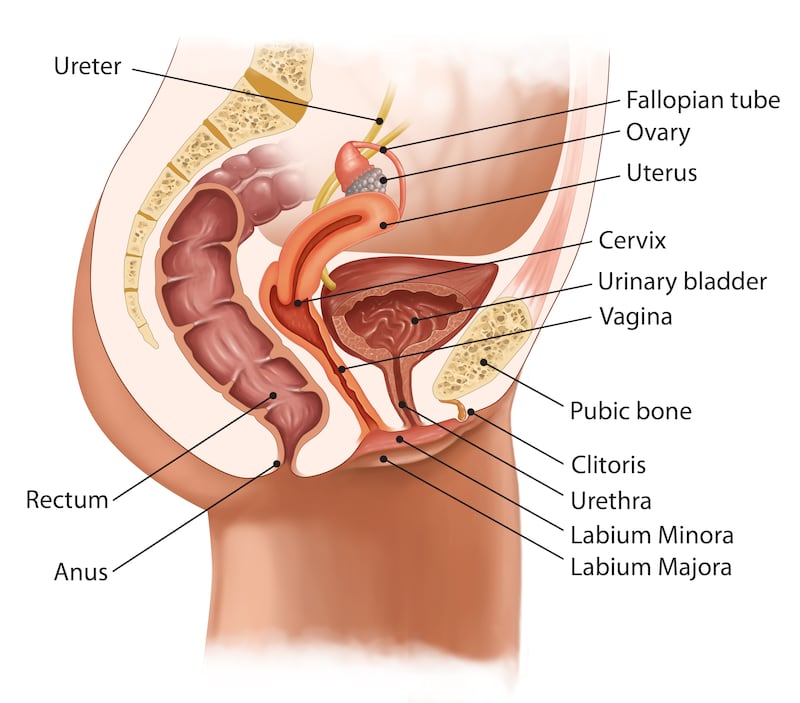It’s not every day that a life-sized model of the clitoris, encased in a plain brown envelope, is dropped through the letter box of our front door.
Made of mauve-coloured soft rubber and silicone, it has come from Australia where anatomically correct models are being produced to promote greater understanding and awareness of this long overlooked and misunderstood female sexual organ. For a start, it is bigger than you might expect, with the wishbone-shaped model measuring 9cm (3.5ins) in both length and breadth.
Prof Caroline de Costa from North Queensland will be handing around samples when she delivers a talk on the clitoris at the Royal College of Surgeons in Ireland (RCSI) this week. She maintains that, even in the 21st century, the anatomy and function of the clitoris is not well-known – not only to women but also to most doctors. It either got scant mention or was omitted altogether from 20th century anatomy text books, which, of course, had extensive, illustrated details about the penis. The sole function of the clitoris is the provision of sexual pleasure to women, being the primary source of the female orgasm.
[ I’ve been faking my orgasms for years — how do I tell my husband?Opens in new window ]
“If it was doing something useful like passing urine or procreation, it might have got a better press,” says de Costa wryly, lowering her voice at times when talking about the topic to The Irish Times in a Dublin hotel lounge, for fear those at the next-door table might choke on their tea. The myth of the “G spot” in the vagina (named after German gynaecologist Ernst Gräfenberg who “discovered” it in the 1950s) arose because stimulation of the front wall of the vagina stimulates the clitoris hidden beneath.
My smear test dilemma: How do I confess that this is my first one, at the age of 41?
Heart disease in women: ‘I was so shocked by news of my artery blockage’
‘I feel lost and lonely. I have begun to think there’s no reason for me here anymore … do any other people feel this way?’
Endometriosis: ‘If I was believed 10 years ago, maybe it wouldn’t be this extensive’
In doing her part to educate people about the organ and promote “cliteracy”, de Costa draws on the work from the 1990s onwards of fellow Australian Helen O’Connell and others. A professor of urology, O’Connell dissected about 50 female cadavers to be able to write authoritatively on the anatomy of the clitoris. She was further helped by some women of reproductive age who volunteered to undergo MRI scans of that area of their body.
The organ is situated right in the middle of everything we do in obstetrics and gynaecology, yet the ‘c’ word is not often spoken
— Prof Caroline de Costa
O’Connell is contributing an enlarged section on the clitoris to the newest edition of the medical training “bible”, Gray’s Anatomy (not to be confused with the TV series of the same name). Back in 1948, this manual had no mention at all of the clitoris and, even as late as the 1995 edition, the details given were inaccurate, says de Costa.
Despite what most people think, there is much more to the clitoris than just the hood and glans that are visible outside the body. In fact, that is only about 10 per cent of what is best described as the “clitoral complex”. The remaining 90 per cent of the organ is concealed beneath the skin of the vulva.
“How is it possible that we landed on the moon before we figured out the anatomy of this important organ?” wondered American conceptual artist Sophia Wallace, who incorporates representations of the clitoris in her work. She is best known for her viral project entitled Cliteracy and, on her website, likens the organ to “an iceberg, similar in scale to the penis, and comprised of erectile tissue”.
When de Costa was editor of the Australian and New Zealand Journal of Obstetrics and Gynaecology (ANZJOG), she invited O’Connell to write an article about her findings. De Costa believed her obstetric and gynaecological colleagues did not know about the extent and physiology of the clitoral complex, nor how its paired bulbs and crura contain erectile tissue that swell with blood during sexual arousal, enlarging the clitoris to the size represented in the models.
Elimination of clitoral sexuality is a necessary precondition for the development of femininity since it is immature and masculine in nature
— Sigmund Freud, founder of psychoanalysis
“The organ is situated right in the middle of everything we do in obstetrics and gynaecology, yet the ‘c’ word is not often spoken,” says de Costa. It is relatively common for women to experience vaginal tears in childbirth that would impact on the clitoris, and which obstetricians, or indeed junior doctors, stitch up.
Likewise, repairs for issues such as stress incontinence involve stitching through the clitoral complex, “but there is no recognition of that in the literature”, says de Costa. “There needs to be more recognition of what tissue has been torn and make sure you repair it so there isn’t a scar that causes pain or painful sex subsequently.”

It is a part of the female body that has traditionally got short shrift in the study of anatomy. The so-called “father of anatomy”, Andreas Vesalius (1514-1564) called it “a new and useless part” after two of his students “found” it. In the first half of the 19th century, German anatomist Georg Ludwig Kobelt did provide accurate detailed descriptions of the organ and surrounding structures. Later in the 1800s and into the 20th century, surgical removal of the clitoris was promoted, with the backing of the British Medical Journal, as a treatment for so-called emotional disorders in women.
Sigmund Freud (1856-1939), the founder of psychoanalysis, believed the clitoris was “infantile” and held that mature women should get sexual satisfaction through their vagina. He wrote that “elimination of clitoral sexuality is a necessary precondition for the development of femininity since it is immature and masculine in nature”. This notion was rejected by later researchers of human sexuality, William Masters and Virginia Johnson, who reported that clitoral stimulation is necessary for most women to reach orgasm.
Dr Karen Flood, a consultant obstetrician and gynaecologist at the Rotunda Hospital in Dublin and a member of the Debunking the Myths team that delivers sexual health education, attended the first lecture that de Costa gave on the clitoris at the RSCI back in January this year. Afterwards, Flood enlisted specialist registrar Dr Maeve White to help gauge the level of “cliteracy” among medical and nursing staff in the hospital.
In June they surveyed 50 people – 10 consultants, 10 junior doctors, 10 midwives, 10 medical students and 10 midwifery students – as a snapshot of staff. Participants were shown the model of the clitoris and asked to name the anatomical parts. The findings, which White is currently writing up, echoed what de Costa has been saying about how the clitoris is overlooked.
A number of people, including at least one consultant, did not even recognise the model as a clitoris, “which is crazy”, remarks White, who readily admits her own knowledge was limited too. “Not one person who answered the survey could name all five parts of the clitoris – and these are people who are fully qualified, or students, and you would think students are more likely to know because they are currently studying anatomy.
“To think we don’t know exactly what anatomy is right underneath where we are putting in stitches is pretty alarming,” she remarks. Although sexual function is incredibly important, the focus tends to be on more “practical functions”, such as the urethra.
“We solely work with women and female anatomy and we should be aware of all the specific parts of the anatomy if we are trying to deal with people with different medical conditions.”
[ Why is the clitoris ignored by so many doctors? Half the world has one, after allOpens in new window ]
White, who is currently working at Limerick’s University Maternity Hospital, says there is talk of introducing even just an hour’s teaching time on the clitoris for students going through the Rotunda, the busiest maternity hospital in Europe. Discussing this sexual organ is, she adds, “still a bit of a taboo – even amongst females”.
De Costa, who is now adjunct professor of obstetrics and gynaecology at James Cook University in Cairns, will be giving a condensed version of her January lecture this week, during a three-day RCSI event for alumnae from various years. She is among 27 (out of the original 120) of the class of 1973 who are attending to celebrate 50 years since their graduation from the medical school on Dublin’s St Stephen’s Green.
A native of Sydney who came to study here after a chance encounter in Jerusalem, de Costa has written about her pioneering career in obstetrics in a memoir entitled The Women’s Doc (Allen & Unwin). As a student and single mother, she participated in a slice of Irish social history by being aboard the “contraceptive train” of 1971, when members of the Irish Women’s Liberation Movement made a very public journey to Belfast to buy condoms and bring them back illegally to Dublin, where the sale of contraceptives was prohibited at that time.
More than 50 years later, Caroline de Costa is still intent on empowering women, by backing the “cliteracy” movement to foster self-knowledge and the pursuit of sexual health and pleasure.




